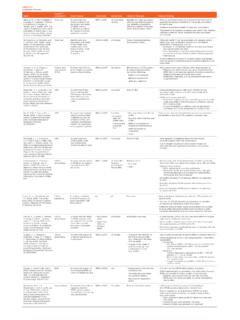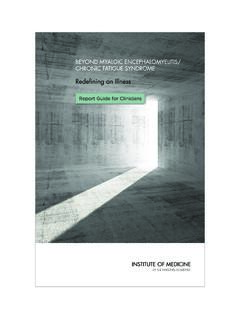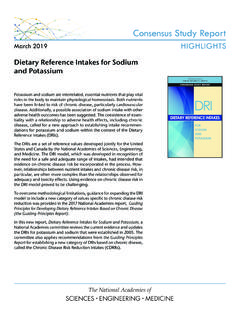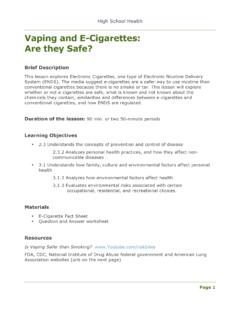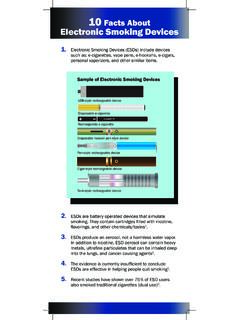Transcription of JANUARY 2018 • PUBLIC HEALTH CONSEQUENCES OF E …
1 RECOMMENDATIONS JANUARY 2018 PUBLIC HEALTH CONSEQUENCES OF E-CIGARETTESSECTION I: E-CIGARETTE DEVICES, CONSTITUENTS, AND EXPOSURES [RECOMMENDATION 6-1]TO DOWNLOAD THE FULL REPORT AND TO FIND ADDITIONAL RESOURCES, VISIT GAPS IN SUBSTANTIVE KNOWLEDGE Study the effects of carrier solvents and additives, including flavor ingredients and device characteristics (including the type of coil and power), on aerosol generation, aerosol physical properties, and the chemical profile of e-cigarette emissions. Study the stability of e-liquid ingredients when heated, identify potential by-products of thermal degradation and of com-pounds that were not initially present in the e-liquid, and ascertain determinants of change in aerosol composition.
2 Study the impact of e-cigarette use in indoor air quality and biomarkers of secondhand e-cigarette exposure in scenarios and exposure surveys that are relevant for the populations exposed, including workers in vape shops and vaping convention attendees, children, pregnant women, and patients with cardiorespiratory disease who live with adults who use e- cigarettes . Conduct research that would inform product standards regarding ingredient purity, batteries and chargers, and priority and novel emissions. Establish procedures to rapidly evaluate changes to products currently on the market, focusing on device designs, design evolution (initiated by both manufacturers and users) and the corresponding alteration of chemical substance release committee recommends that the Food and Drug Administration (FDA) and other federal research sponsors and/or device manufacturers prioritize e-cigarette research that addresses key gaps regarding knowledge about e-cigarette devices, constituents, and exposures; on the HEALTH effects in individuals.
3 And on harm reduction and PUBLIC HEALTH implications of e- cigarettes . This might include rapid response funding opportunities. SECTION 2: EFFECTS OF E- cigarettes ON HEALTH [RECOMMENDATION 15-1]Animal Models and In Vitro Mechanistic Studies: Mechanistic and in vivo animal studies should be done to determine the potential effects of e-cigarette aerosol on organ development and tissue growth during embryonic and fetal development. Such studies should assess effects of nicotine and flavorings separately, and include both dose response and time course effects throughout the period of gestation.
4 Long-term (2-year) animal studies should be conducted, using inhalation exposure to e-cigarette aerosol, to better under-stand disease risks from inhaling reactive carbonyl compounds and other potentially toxic constituents of e-cigarette aerosol, including flavoring chemicals and additives. These studies should include two controls: combustible tobacco smoke exposed animals and those exposed to ambient air. Endpoints evaluated should include clinical outcomes and biomarkers relevant for, at a minimum, cancers, cardiovascular disease, and respiratory diseases and other relevant clinical outcomes.
5 The effect of e-cigarette aerosol on pulmonary inflammation and clearance of viral and bacterial pathogens in the lungs should be studied in appropriate animal models following inhalation Human Studies with Clinically Relevant Biomarkers: Particle deposition in the human airways should be evaluated to assess where e-cigarette derived particles impact the upper versus lower airways and alveoli, and how area of impaction in the lung may influence HEALTH effects caused by e- cigarettes . Such studies should also include evaluation of airway epithelium repair. Periodontal disease should be evaluated in e-cigarette users who have not been users of combustible tobacco cigarettes , including the effects of e- cigarettes on the subgingival microbiome.
6 Short-term biomarker studies in humans are needed that focus on pathways with relevance to cancer, cardiovascular disease, respiratory diseases, and other disease endpoints, including biomarkers of inflammation and immune status, oxidative stress, and gene expression. Panel studies should assess the association of changes in e-cigarette use, including device characteristics and patterns of use, with relevant markers of subclinical cardiovascular disease (blood pressure, endothelial dysfunction, arterial stiffness, cardiac geometry and function, and autonomic function) and respiratory disease (lung function, lung imaging) under real-life conditions.
7 Short-term physiological effects of e- cigarettes on the mother and fetus should evaluate the potential for more clinically consequential Clinical and Epidemiological Studies: Longitudinal cohort studies should be done to assess the association of long-term use of e- cigarettes with clinical and sub-clinical cardiovascular, respiratory, and other HEALTH outcomes as compared with smoking combustible tobacco cigarettes , dual use of e- cigarettes and combustible tobacco cigarettes , and never smoking or vaping. Because prospective studies for clinical disease take very long, cross-sectional studies of e-cigarette use with subclinical mea-sures of cardiovascular disease and respiratory diseases can be very useful.
8 For instance, carotid atherosclerosis and coronary artery calcification can be measured subclinically and inform on clinical cardiovascular risk. Similarly, lung imaging data can provide relevant information on the effects of chronic e-cigarette use before clinical respiratory disease has manifested. Studies are needed on the association of second and thirdhand exposures with HEALTH outcomes in vulnerable populations, such as pregnant women, infants, young children, the elderly, and patients with cardiovascular and respiratory diseases, compared with secondhand tobacco smoke and the absence of secondhand exposure to both combustible tobacco smoke or to e- cigarettes .
9 More research is needed on clinical and epidemiological studies of e-cigarette use during pregnancy, evaluating the associa-tion of patterns of use (including sole and dual e-cigarette use) with maternal and infant outcomes, building on known effects of tobacco on pregnancy complications and neonatal HEALTH indexes, compared with mothers who continue to smoke during pregnancy and never smokers or vapers. Systematic collection of data is needed on injuries, poisonings, and other harms caused by e-cigarette devices in prospective observational studies of e- cigarettes . Identification and evaluation strategies, including product standards, are needed to minimize the number of accidental burns and injuries caused by e-cigarette malfunctions and explosions.
10 Epidemiological studies should be conducted on the dependence construct and whether the symptomatic manifestation of e-cigarette dependence are different from those of other tobacco or nicotine-containing products. The relationship between smoking history and nicotine pharmacokinetics (PK) should be assessed. Specific areas for exam-ination include how smokers history and dependence influence nicotine PK and effects when switching to e- cigarettes and how nicotine PK would be predicted to change over time. Longitudinal cohort studies are needed of youth and young adults to understand the trajectory of dependence over time in users with little or no combustible tobacco product exposure.




